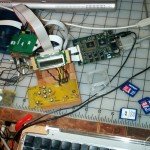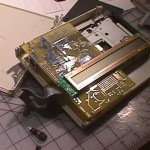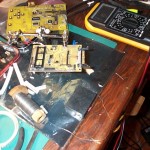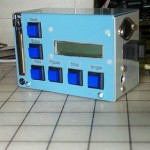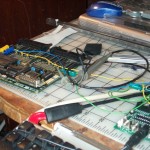A recent search on github for code relating to stereo 3D photogramertitry and synthetic computer generated holograms. lead me to the paper Holovideo on a stick, Integrated Optics for Holographic Video Displays by Daniel E. Smalley[1]
Most intriguing was the statement “If you want a Hologram video monitor, you have to make it yourself. Now I love do it your self projects. Ones that are most complicated. Not that I need another project, I have enough as is to keep me occupied for at least 500 years. In a way this is one of them. I always wanted to make my own hologram. My interests in Holography date back to the 1960s and the exhibits in the Exploratorium and the Laserium. In may ways such a device, would actually help in the other projects, giving a tool to use in visualizing how such things as the Antikeythera device, or Babbage’s computer are designed to work.
MIT has made much of their research available on github[3] with the admonition “We hope that hobbyists and researchers around the world can be inspired by and use this code to help achieve the goal of creating high-quality consumer holo video displays.”
Is this a practical statement? Can one make a Holographic Video monitor? After reading through the paper I would say a qualified ‘yes.’ There are a number of broken or incomplete links on the website. A note pointing out these broken links, to Dr Smalley public email address, was not quickly answered. It does not seem that there has been much publicly shared since 2014. There are some impressive You tube videos, which only seem to have 14 or so views. None of the links to the Mark-V version of the project work other than showing a plexiglass case.
The Mark-IV project is well documented. This seems to relate directly to Dr Smalley’s thesis[1]. I found this thesis to be lucid and well, written and thought out. It really does imply that one can make a Holographic video monitor. Much of this reminds me of computing in the early 1970s. And the 3D printer craze in the late 2000s.
Dr Smalley and his team have broken down the design into a series of sub modules. One of which is an Arduino. Of these modules the easiest item to source is the floating coin (or floating frog illusion.) This was a popular attraction at the Exploratorium. This curved reflector also gives the display it’s distinctive look.
The electronic modules also look fairly easy to replicate. I have done a lot of printed circuit boards. The first SMT PCB I did in the early 2000s was for a surplus LCD camcorder video display, which required obsolete parts distributed amongst the overstock dealers. These were from a 1990s era Cybermaxx Virtual reality headset. One of these headsets can be seen in the opening scenes of the movie _Titanic_. Where the sub operator is exploring the wreck.
Andrew Henrie’s[2] documentation of the Mark-IV display refers to PCBs as CCAs, Which I take to mean Circuit Card Assembly. I will retain this terminology for the completed assembly. These CCAs are both well documented and obscurely sketchy. There are photographs of the PCBs as well as links to the data sheets of the chips involved. Nowhere is a schematic with Bill of materials, or any sort of layout pdf, or Gerber. One of the CCAs is an Arduino with shield. From the photographs the shield is simply a solder-less prototyping breadboard. The function is to support a DAC.
Not well documented is the post amp that the DAC uses to drive the Galvanometer. The closest thing to a schematic is an online simulation of the synchronization CCA with an absurdly long link. This Java applet surprisingly works well, and can be saved offline, incase the website goes down. This sim applet may be useful in the future should one want to simulate simple circuits, without a full blown spice model. It is not clear the photographs show hex switches which I actually have some of in my junk box. There is also a spectra stripe ribbon cable who’s function is not apparent, as well as a bank of electrolytic caps.
It is evident that much of this prototype is made from surplus parts. I love surplus stuff. Of the surplus items, used in the Mark-IV sub-assemblies, I am most familiar with the Polygon Mirror unit. I worked for most of the 1990s at Apple Imaging, where I wrote tests in postscript for the laserwriters. Some of us were also into robotics and we were given permission to go through the trash recycle for project parts. When the prototype printers were scrapped, a screwdriver was driven into this assembly to smash the laser optics. Still one had access to the sensors and servos to play with, as well as the data sheets giving the specifications. These were either made by Cannon or Fuji Xerox. From the marking in [2] it looks like a Fuji Xerox unit from a Sharp printer is used.
Laser-printers have a consumables lifespan of about 7 years. This means that the polygon units are somewhat available in the surplus markets. Pretty much for cheap if not free. There is also a tendency to put these into storage when their usefulness expires. These then get donated to co-ops and other shared resorce projects.
The local maker-space broke up a dozen or so printers for the gearing, stepper and servo motors. I have used the rollers in my crank organ and piano roll scanning projects. The screws and springs are also quite useful. I found one of these polygon units in a junk box at the local maker space. These were pulled from copy scanners (Probably HP) most of the polygons have 4 sides. I found one with 6 faces. An online search located the motor driver chip datasheet. There are a number of videos of polygon assemblies being run off arduino boards to create the PWM frequency needed. Also in the junk box were a number of planar mirrors.
Markings in the photographs[2] show the exact model of the Galvanometer used. A search of this part number currently shows this to still be a popular eBay item. Although a bit on the pricy side. These units seem to be used in point of sale grocery scanners. The tricky part would be to source the lightweight mirror, which is a section of aluminized silicon wafer. It may be possible to use one of the junk box mirrors ground down. The next group of assemblies to look at start with the Amplifier CCA. Again there is no schematic or board layout other than the photographs. The parts are given as data sheets. There is also a Carrier CCA, which it is indicated was not used in the documented project. The Amplifier board being directly driven by a fairly common NVIDIA GPU board. Such GPU boards also currently seem to be on eBay.
In reference [2] There is a whole appendix on debugging the amplifier board. Photographs show a hand soldered surface mount PCB. Having done home made SMT PCBs for over 20 years I can see the over abundance of excess solder on the component leads. A reflow oven and a proper solder paste mask would probably be on order here. Like the synchronization CCA the parts used on the amplifier CCA are easy to source through the main line distributers.
Now we come to the tricky part, which could be a real show stopper. This is the Acousto-Optic Modulator. Maddeningly the paper gives a specific part number. Which comes up ‘not found.’ or ‘Not available.’ A call to the manufacture asking for a data sheet an possible purchase was pleasantly responded to, however at the time of this review, a return call from an engineer has not happened.
Acousto-Optic Modulator’s are for sale on eBay ranging from 50USD, to over a thousand USD. There is not any documentation on these units. It looks like one would have to put a pin in it and order one blind to see what it does. It may be that quite a few channels are needed. There are references to 18 channels. The online search algorithms are not fine enough to separate out anything relating to channels. Searches for Acouso-optical modulator and Bragg cells return the same results.
It is evident that the Acousto-Optic Modulator is Dr Smalley’s first love. In his thesis he details the design and manufacture of such devices optimized for Holographic display use. It really does make one feel like one could follow the instructions. That it would be as easy to build as an adirondack lawn chair.
Now people like Jerri Elseworth and Sam Zeloof have built chips in their garage. I suspect there are others. Even I have acquired some surplus chip making equipment, which I used to make the Adelmous Fey mechanical doll[4]. As well as extending some of my watchmaking tools.
So in theory could one build the wave guide Dr Smalley details in his thesis?
First a search of the materials shows they are readily available. Lithium niobate blanks are listed from the suppliers with prices of around 20USD. Benzoic acid is a food supplement. Aluminum is something we put in the recycle bin everyday.
Physically enhanced chemical vapor deposition does not look to be too difficult. One of my friends in the Science Fiction/costuming community builds such machines for the Spintronics research department at IBM. He has given lectures on how such chambers work. I have myself built vacuum forming machines for prop making. An efficient Vacuum pump is going to be the critical component. There are also very efficient 18th century vacuum pumps. Player pianos and Pneumatic band organs such as my Wurlitzer Caliola also have high volume/flow pumps. Most of these pneumatic devices are fairly leaky. The real trick would be to avoid crushing the container and the furnace.
I have experience in high temperature enamel painting for making mechanical bird case and the restoration of watch dials. I have not gone as far as to build a (PECVD) but as far as I know Silicon dioxide is the main ingredient in glass. It is also called sand, occurs naturally in obsidian, and is one of the most common elements on this planet. My back yard is full of it.
This means in effect that a layer of glass is deposited onto the wafer as a mask for etching into. Then dissolved off. This is something I have done at the macro level with crystalline paints and lithographic processes. I have not attempted it at the nano level. I have ground up old LCD displays and silicon wafer fragments and put them in the kiln to see if they can be used in the art projects. (usually with the pure materials there is no eutectic flow.)
There are a number of projects on-line for flowerpot forges which can be used to cast aluminum from recycled materials. My guess is that for aluminum depositing the material cost is negligible. The tricky part would be doing this at the nano level in a clean environment. How small can a furnace be made. Could a glove box be used? At this point the project seems perfectly feasible.
Now we come to the showstoppers. There is a tradition, probably going back to Philo and Hero of Alexander, of leaving something out in the patent documents. This small detail can be figured out by those who are already in in the know. In Figure 4-2[1] the dimensions of the waveguide are given in detail, as are the theory of how he arrived at them. Unfortunately the key of measurements duplicates the Goldberg letters b through I. The letters for the transducer dimensions j,k,and l are not in the key.
Titanium indiffusion is also a grey area. Searches on this term mostly return academic papers behind paywalls. TI could be a reference used to the glass mask which gets etched away. I forget what this mask type is called.
The main showstopper is that to etch the wave-guide, one would need an electron microscope. Sam Zeloof may have one of these in his garage, but building that alone could be a multi year project. The idea here is to make a Holographic display. I would only want to etch wave guides once (or perhaps 3 times for RGB separation.) This showstopper is also the qualify on ‘Yes’ above.
‘Yes’ one can make such a display, If there is a team that is wanting to do it with the necessary skill sets and the motivation to see it through without distraction. If one could source the AOM from a telecom device, the rest of the items are pretty much off the shelf.
I am still inclined to give it a go. I already have the polygon and some mirrors. The next step will be to order what parts I can while they are available on the second hand and overstock markets.
Most likely I would start with the PCBs for the Syncro, and Galvo CCAs. Then proceed to the amplifier CCA. Probably with a single channel. There is a consistent theme in the literature, that widely available displays are the goal of this research. To move the technology out of the lab and into the hands of the early adopters. The Hobbyist, and the entrepreneur.
A Hobby project is something I would like to do. It feels as though the time is right. Especially as many are locked down due to SARS Covid19. Who would not want a 3D telepresence display. Most existing 3D display technologies require a viewing aid, glasses or a cumbersome headset.
It is unclear as to why the data reviewed here that was released in 2015 has not been more widely distributed. Where are the promised Hobby projects? Online searches do not show much advancement after 2016. The YouTube Channel Abandoned. Nor do there seem to be efforts to commercialize this. To me I see a perfect opportunity for a Kickstarter type approach. Especially in the creation of AOM units optimized for holographic display.
- Holovideo on a stick, Integrated Optics for Holographic Video Displays by Daniel E. Smalley https://dspace.mit.edu/bitstream/handle/1721.1/91855/894260144-MIT.pdf?sequence=2&isAllowed=y
- H​OLOGRAPHIC​ V​IDEO​ M​ONITOR M​ARK​ IV https://docs.google.com/document/d/1JvHrZEMUS5qvImYyeAH0q8PM69rNP406YdpW3j1FRGI/edit#
- https://github.com/itsermo/holovideo-mit.git
- Adelmous Fey http://www.delectra.com/adelmous/index.html
